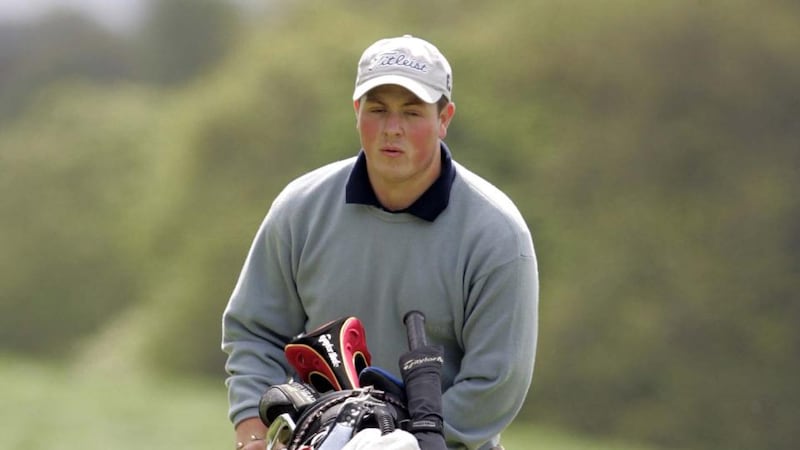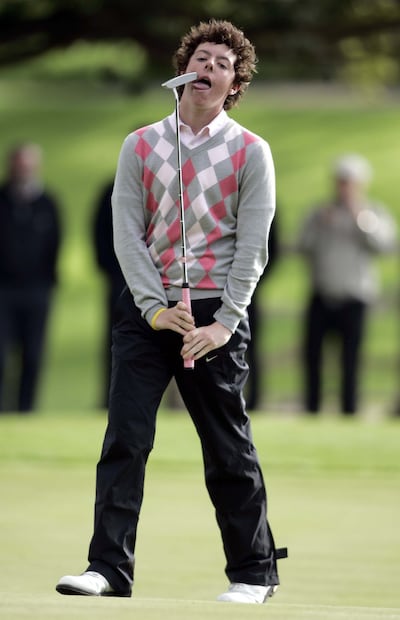Stephen Crowe has a place in golf folklore – bearing witness to a course record 61 at Royal Portrush that, given the changes to the course, can now never be bettered.
The date, July 12th, 2005, never got etched in stone. Stroke-play qualifying at the North of Ireland Amateur Open – a weeding-out process before the serious business of match play – is typically fodder for the daily paper fact file.
Now 36, and a father of two boys, Crowe has good reason to remember the details of that day. While he played for Ulster and for Ireland (Youths) in his prime, he glosses over those facets whenever asked about golfing pedigree. Once preliminaries are out of the way, a familiar question floats into the conversation.
Did you ever play with Rory McIlroy?
“Yes, actually,” he replies, satisfaction still brimming. “I played with him when he shot 61.”
His pride has a soft spot: “So long as nobody asks what I shot.”

Fortunately for Stephen, his numbers are not recorded on McIlroy’s extraordinary card. As witness to the famous feat, Crowe had a fundamental contribution to make. Rarely was an inky scribble such essential testimony.
“I’m glad I’m only on the scorecard as the marker’s signature,” Crowe admits.
Mention of McIlroy’s 61 is enough to suspend all other enquiries. Time has not diminished this achievement. If anything, the years have varnished it, adding new layers to startling schoolboy images.
“No matter what he does in golf, he shot 61 at 16 around one of the best golf courses in the world,” Crowe says. “Nobody’s going to take that away from him.”
Given what this four-time Major winner has accomplished since those heady early days, grasping the impact of his breakthrough can be hard.
“He would have been signing autographs after a round, which was unheard of in amateur golf. He was probably signing autographs for guys who were older than him.”
Thoroughbred
An eerie feeling enveloped others there that day. Kenny Fahey, who played for Ireland at Boys level from 2000 to 2001, was home following his final year at the University of Rhode Island. He qualified comfortably, four shots inside the cut, but McIlroy dominated thoughts.
“It was more like silence around the clubhouse,” says Fahey. “He didn’t even go on to win the North and no one cared. When a thoroughbred just shines and you get a chance to be around that, it’s really special.”
Fahey, head professional at the GUI National Golf Academy since 2014, is reminded of a forlorn impression: “If that’s what good looks like, I definitely cannot do that.”
Word about the boy wonder from Holywood, Co Down, had already spread across the Atlantic.
“When I was in the States, I had heard about him,” Fahey notes. “Every coach has a player that they think is going to be the real deal but once in a lifetime comes a player who is the real deal.”
Crowe had appeared, for Ulster, alongside McIlroy. Although there were six years between them – Crowe then 22, McIlroy just 16 – playing alongside the boy evoked excitement in the man.
“When you were playing with somebody like Rory, it was a pretty good draw to have,” Crowe confirms. “At that point, he was the best player in Ireland. Any time you were on a golf course, you knew where Rory was because he always had a crowd.”
After a so-so first round of 71on the Valley Course at Royal Portrush, Crowe had no inkling McIlroy was set to conjure something for all time.
“You might have thought he’d go out and shoot mid-60s,” Crowe maintains. “He was two under after eight, which was a good score, but you don’t think he’s going to do what he did. Then he birdied nine, eagled 10 and birdied 11. All of a sudden he was six under. It was like an explosion.”
Very good golfers take stock in such situations: “If you get under par on Dunluce, you’d be playing for the pars. Try to shoot 67 or 68.”
McIlroy, destined for greatness, made the difference seem stark: “Rory just kept going. He had that self-belief and confidence in himself.”
McIlroy settled for mere pars on 12 and 13. The 14th, Calamity Corner (which now plays as the 16th following the re-routing for the British Open), presents as daunting as its name suggests. The green is perched atop a grand dune and the drop appears like golf’s great canyon to the right. Miss and your ball is dead.
Crowe still pictures the tee shot: “He hit a big high draw out over the valley into the middle of the green. It was one of those shots you wish you could hit yourself.”
A birdie moved McIlroy to seven under. On he went, in that fashion, to the finish.
Nothing fazed him. He never backed down. He knew he had the ability to pull off the shots. He would always try to pull off the crowd-pleaser."
“I think, when the crowd got bigger, he started to play better,” says Crowe.”He birdied the last five holes.”
On 17, the last par five, the swell in numbers led to practical problems.
“I couldn’t hit my shot,” Crowe recalls. “I had to say to people: ‘Excuse me, do you mind moving back?’ It wasn’t getting out of control but it would have been no harm to have a marshal there.”
McIlroy looked at ease. His playing partner sensed as much: “He would have been hitting driver off a lot of tees when you would have been hitting irons or 3-wood. I wouldn’t have had the same mindset.”
The tee shot at 16 framed the McIlroy mentality. Even now, one quivers to think about the drive he hit.
“The 16th was terrifying,” Fahey says. “The fairway used to bottleneck down at the bottom right corner into a pathway up to the green. It was an incredible shot at eight under par. I don’t think I’d hit driver down there at nine o’clock in the evening on my own with a shag bag.”
Here was the thing with McIlroy, confidence from a long way back. His assuredness had been apparent, aged nine, when he chipped a ball into the drum of a washing machine live on television.
“Nothing fazed him,” Crowe insists. “He never backed down. He knew he had the ability to pull off the shots. He would always try to pull off the crowd-pleaser.”
With a closing birdie, McIlroy completed the record-breaking round in suitable style. His tally: eight pars, nine birdies, and that eagle at 10. Out in 33, he came home in 28.
‘Down to earth’
Crowe cannot recall exactly what he said to McIlroy after they shook hands on 18. He suspects their exchange went something like this: “Ya little bugger. How did you do that?”
Like his Ulster team-mates, McIlroy enjoyed the joking and the joshing.
“We always had a bit of craic,” says Crowe. “He was down to earth. He would always stop and speak to you. He never got too big for his boots.”

By the time McIlroy turned professional, Crowe was still competing strongly as an amateur. One year at the West of Ireland – the first major of the season – they were reunited for a practice round. Harry Diamond, McIlroy's caddy and best man at his wedding, played that championship too. So McIlroy, in want of a good game, joined them on the links at Rosses Point.
Unabashed, Crowe sought an autograph from the fledgling pro so he could give a signed golf ball to a friend’s son.
“There was nobody as special as Rory. I always said: ‘If Rory didn’t make it, nobody would.’
“It’s nice to say I was there. I’m sure he would have shot that score playing with whoever else. It’s always something I can talk about.”
McIlroy could reclaim the Claret Jug, at Royal Portrush next Sunday, and clutch that Holy Grail on ground he helped make famous.
Regardless, Crowe will forever recall a summer when Rory was 16, and one game he played so sweet.












